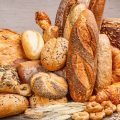Most may find that when starting out with baking your own sourdough bread, preparing the starter can be a little scary. After all, though it is basically made of flour and water, the starter is a live fermented culture. Once it becomes bubbly, that is a clear indication that it is active, and ready to use to make your sourdough bread. If anything, the most laborious part of this task, would be to keep your starter alive. And if you’re new at it, things like healthy starter aromas might not be familiar to you yet. Do you find that your starter has begun to emanate some unpleasant smells? Lets take a look at some of the reasons for why that is, and ways to fix it.
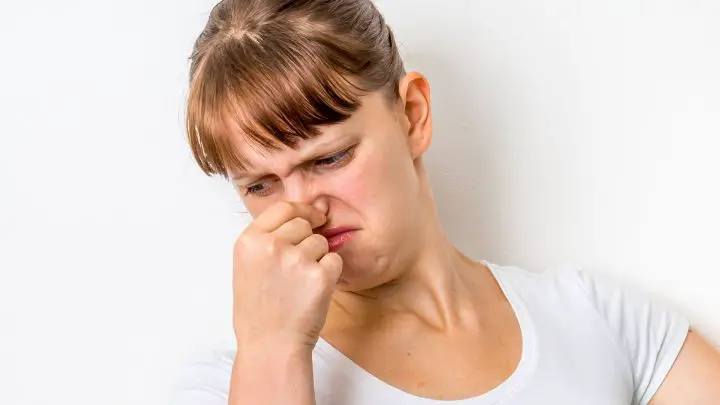
Table of Contents
- Why Does My Starter Smell Like Socks?
- Why Does My Starter Smell Sweet?
- Why Does My Starter Smell Like Cheese?
- Why Does My Starter Smell Like Acetone?
- Why Does My Starter Smell Like Alcohol?
- Why Does My Starter Smell Like Vomit?
- Why Does My Starter Smell Like Vinegar?
- What Should Sourdough Starter Smell Like?
- What Should My Sourdough Starter Look Like?
- How Long Should Sourdough Starter Ferment?
- How to Fix a Starter that Smells Bad?
- What to Do if My Starter Goes Moldy?
- Why is my Sourdough Starter Forming a Skin?
- Why is There Liquid on Top of My Sourdough Starter?
- What is the White Stuff Growing on My Starter?
- What Happens if I Forget to Feed My Starter?
- What is a Sourdough Discard?
- So What’s that Smell Coming From My Starter?
- Sourdough Starter Smell FAQs
Why Does My Starter Smell Like Socks?
The smell of your starter can be a little bit off-putting. You may find yourself comparing it to old gym socks, rotten eggs or even vomit.
This is not a cause for concern, though. It’s just the bacteria doing its job and creating good acids as they go about their business.
The smell will settle down after a few weeks as the good bacteria take hold and start producing lovely fruity smells. Once your starter is established it should release only delightful aromas whenever you open up your jar or put some dough into it for baking or cooking.
If you’ve got an established sourdough starter but it still smells bad, try feeding it with some flour and water every few days. Do this until you get back those lovely fruity aromas again.
Why Does My Starter Smell Sweet?
When your sourdough starter smells sweet and fruity, that’s a great sign! It means the yeast is doing its job, eating up the sugars in the flour and making carbon dioxide and alcohol. As the yeast grows, it makes more of this sweet smell, which tells you that your starter is healthy and ready to make yummy bread.
Don’t worry if the smell reminds you of ripe fruit or even nail polish remover. That’s just part of the process as the yeast chows down on the sugars. It might seem weird, but it’s totally normal. Think of it as a sign that your starter is alive and kicking, all set to help you bake some awesome sourdough.
Just remember to keep things in balance. If your starter starts smelling too sweet or boozy, it could be telling you it’s hungry and needs more food. Make sure to feed it regularly, so the yeast and bacteria stay happy. That way, your starter will stay in tip-top shape and give you great results every time you bake.
Why Does My Starter Smell Like Cheese?
This aroma is a sign that your starter is developing a healthy balance of bacteria. The cheesy odor is caused by the production of lactic acid, a byproduct of the fermentation process when bacteria break down the sugars in the flour.
Lactic acid gives your starter a tangy, slightly sour flavor and contributes to the development of that coveted cheesy aroma. It’s a sign that your starter is maturing and developing a complex flavor profile. Many bakers even strive to achieve this distinct aroma in their starters, as it indicates a robust and flavorful base for their bread.
Embrace the cheesy goodness! As long as your starter is doubling in size, has a bubbly texture, and passes the float test, you can be confident that it’s ready to create some delicious sourdough bread with a unique, tangy flavor.
Why Does My Starter Smell Like Acetone?
This smell is a common occurrence and usually indicates that your starter is hungry and needs to be fed.
When your starter runs out of food (the flour you feed it), the yeast begins to produce ketones as a byproduct of its metabolism. These ketones are what give off that sharp, acetone-like aroma. To get rid of the smell, simply give your starter a fresh meal of flour and water.
If you find that your starter is consistently developing this acetone smell, it might be a sign that you need to adjust your feeding schedule. Try feeding your starter more frequently or increasing the amount of flour you give it during each feeding. With a little trial and error, you’ll find the perfect balance to keep your starter happy and smelling great.
Why Does My Starter Smell Like Alcohol?
This distinct boozy aroma is a normal part of the fermentation process. As the yeast consumes the sugars in the flour, it produces ethanol (alcohol) as a byproduct.
This alcoholic phase usually occurs when your starter is at its peak activity after feeding. It’s a sign that the yeast is working hard, converting carbohydrates into the bubbles that will make your bread rise.
However, suppose the smell is overpowering or persists for an extended period. In that case, it might indicate that your starter needs more frequent feedings or an adjustment in the flour-to-water ratio.
So, when you notice an alcoholic scent from your starter, just smile and know that it’s a natural part of the sourdough journey.
Why Does My Starter Smell Like Vomit?
This odor is caused by butyric acid, a byproduct of fermentation when certain bacteria take over. Butyric acid gives vomit its distinct, foul smell, indicating that something has gone wrong in the balance of bacteria and yeast.
This vomit-like smell usually occurs when your starter has been neglected or left unfed for too long. To fix it, remove any liquid or discolored portions, transfer a small amount of healthy starter to a clean jar, and feed it equal parts flour and water. Repeat feeding every 12 hours until the smell disappears and your starter is back to smelling fresh. Remember, a healthy starter should have a slightly tangy, fruity aroma. If you catch a whiff of vomit, give your starter some extra TLC to get it back on track!
Why Does My Starter Smell Like Vinegar?
Vinegar aroma is common and usually not a cause for concern. The smell comes from acetic acid, which is produced when acetic acid bacteria feed on the ethanol (alcohol) created by yeast during fermentation.
To manage the vinegar smell, try feeding your starter more frequently, experimenting with different flour types, or adjusting the hydration level. However, if you notice mold growth or excessive acidity alongside the vinegar smell, it might be time to take action.
A little vinegar aroma is a normal part of the sourdough process. With some minor adjustments and patience, you’ll be crafting delicious, tangy loaves in no time!
What Should Sourdough Starter Smell Like?
When your starter smells like a healthy, active yeast culture and not ammonia, rotten eggs or mold, you’ll know you’re on the right track.
Sourdough starters will have their own unique scent that’s either sweet and yeasty, or sour depending on the type of starter.
If your sourdough starter smells like alcohol or acetone, then it’s not quite ready yet. In fact this is an indication that your starter is really hungry, and has produced lots of acetic acid.
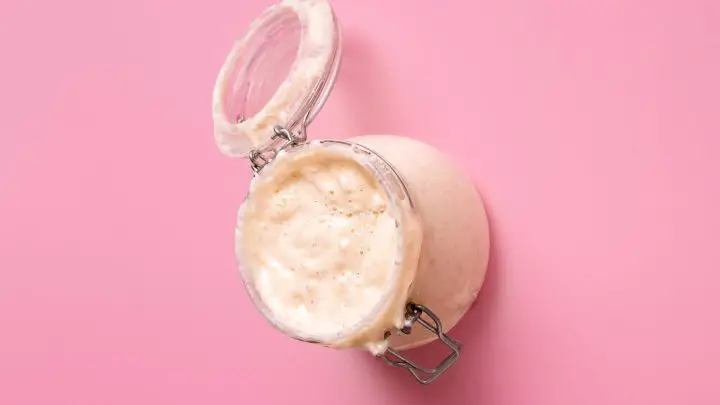
What Should My Sourdough Starter Look Like?
In order to determine if your starter is healthy and ready to be used, you need to know what a healthy-looking sourdough starter looks like. Every sourdough starter has a different personality, so there’s no one perfect way for it to appear when it’s ready for use.
A good general rule of thumb is that the more active your starter is and the older it gets, the more likely it will have some bubbles on top and maybe even a little foam during feeding time. When you feed your starter, you should see some bubbles rising to the surface as well as some activity going on in the bowl or jar where you keep it stored.
The best way to determine, whether your starter is in need of some help is simply through taking a look at how runny your sourdough starter appears to be.
If your mixture develops a thick or soupy texture, without any visible signs of fermentation happening, then this can indicate that something isn’t right with your starter. These factors may also cause odors associated with an unhealthy sourdough starter.
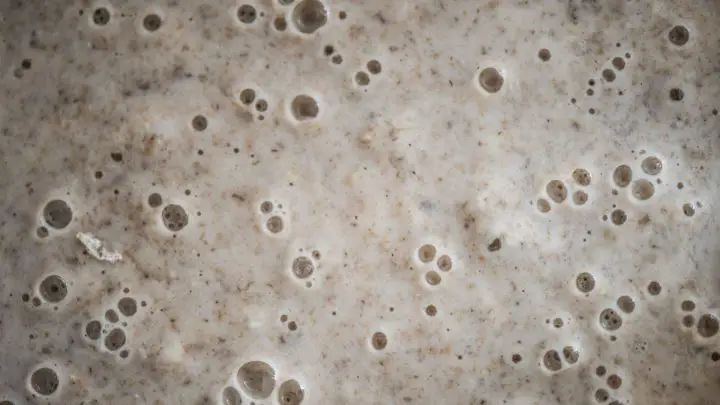
How Long Should Sourdough Starter Ferment?
The length of fermentation depends on how active your starter is.
Pay close attention to the visible clues that indicate that the starter is ready to use.
If the sourdough doubles in volume, is active and bubbly, as well as passes the float test, then its ready to use. This could take from 2-10 hours, depending on how cold its environment is at this time.
This is what we would call a mature starter – one which has been fed regularly and had enough time for its culture to become established. Every time you feed it will produce a consistent result every single time!
How to Fix a Starter that Smells Bad?
If your starter is constantly releasing a sour smell, try increasing the amount of times you feed it. If you feed it once a day, try twice a day.
You can also try to switch to feeding your starter all purpose flour, if you initially use whole grain flour. Whole grain flour makes the starter more active, so it will consume its food more rapidly.
If that doesn’t fix the problem, then try using your starter soon after it has reached peak fermentation. This allows there to be a better balance between the acetic acid and lactic acid from the bacteria which can reduce some of that unwanted sourness in your breads.
What to Do if My Starter Goes Moldy?
If you notice a pink, orange or furry residue forming on the surface of your starter, it is time to discard and start over. The mold formed is caused by bacteria in the flour used to make the starter. If this happens multiple times when making your starter, then consider switching flours for a different one as the mold spots come from within the flour itself and not from its environment.
Any signs of mold atop your starter, whether small or large should result in the entire jar of starter to be thrown out. Though it might be tempting, refrain from scooping out the mold to discard and use the rest of the starter.
Once the mold has formed, the starter isn’t salvageable. So throw it all away!
Why is my Sourdough Starter Forming a Skin?
If you’ve ever used a sourdough starter, you’ve probably noticed that it forms a skin on the surface of the starter.
Don’t worry! This is normal and nothing to be concerned about.
However, sometimes this skin can develop too quickly if your starter isn’t being fed regularly enough or if there’s not enough moisture in your kitchen.
It’s important to note that there are two types of yeasts:
- good ones that work with flour and water to ferment bread dough
- bad ones that can potentially cause illness (like an infection)
The latter will grow faster than the former because they have more food available to them even though they’ll eventually die off when exposed to air.
So what should you do if your starter develops this phenomenon? There are a couple solutions:
- Remove any old skin from your jar before adding fresh flour-and-water mixture each time (you may need an old spoon).
- Make sure there is always enough water present when feeding it. Otherwise place a lid loosely on top so moisture doesn’t escape too quickly through evaporation during rising periods (this will prevent excess air circulation inside the container).
Why is There Liquid on Top of My Sourdough Starter?
Once you’ve successfully maintained your starter for a few weeks, you may find that there is some liquid forming on top. This dark liquid, known as hooch, is perfectly normal and can be easily fixed.
Hooch is caused by the fermentation process, which results in alcohol being produced by bacteria living in your starter. As these bacteria feed on the flour and water mixture they produce alcohol as waste material.
The longer you go without feeding your starter, the more likely hooch will form. This is due to lower levels of available nutrients for them to consume and thus fewer food sources (and therefore less fermentation).
Hooch has a slight alcoholic smell which can be detected when pouring off or mixing back into your sourdough starter; however it does not mean your starter has gone bad! It’s a natural result that occurs when our starter has been left a little hungry, it’s simply telling you that it’s feeding time.
Your sourdough should still taste fine even if there are traces of hooch left over from previous feeds – just make sure to mix everything together well before using it again!
Alternatively, you can read more about the liquid forming on top of your sourdough starter, if you’re a little lost at this stage.
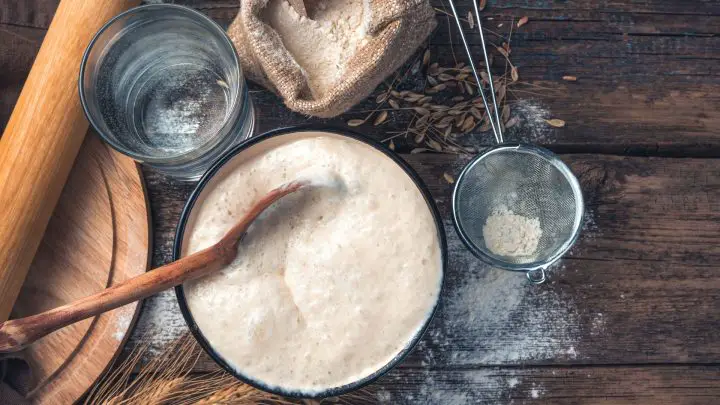
What is the White Stuff Growing on My Starter?
If you see white clusters, or a white film that appears to be mold on your starter, this is most likely kahm yeast.
Kahm is not dangerous, but it can make your sourdough starter taste a bit funky.
To tackle this: take some starter from the middle of the jar and transfer it to a clean jar, feeding this as normal. Wash everything thoroughly (including any equipment used) to get rid of any remaining kahm yeast.
What Happens if I Forget to Feed My Starter?
If you’ve neglected your starter for a few days, there’s no need to panic. It won’t be destroyed forever. You just need to get it back into a healthy state by giving it more care and attention.
If your sourdough smells off and breaks down too much when you feed it, then the best thing to do is throw away all of the old batch of starter (except for one teaspoonful). Start again with new flour and water. You can use this method as often as you like until your starter has regained its vibrancy, bubbling action and pleasant smell.
It’s important not to leave any leftovers from feeding in the jar as they will eventually go moldy due to lack of activity in them. So if there are any discolored or smelly bits at the bottom of a jar after feeding, discard them along with their contents immediately!
What is a Sourdough Discard?
Discard is the term used to describe the small amount of sourdough starter that you throw away. Not discarding before feeding your starter can cause too much acidity in your starter.
In order to allow your starter to grow and flourish, you need to refresh it with fresh flour and water. Discarding some will allow you to add fresh food, whilst maintaining the starter at a good size.
You don’t have to completely throw the discard away. Instead you can use it in some later recipes, or as a base for making an awesome batch of sourdough discard bread!
It’s best not to use it for at least 7 days so that there are no traces of old flour left over from when we last fed our sourdough.
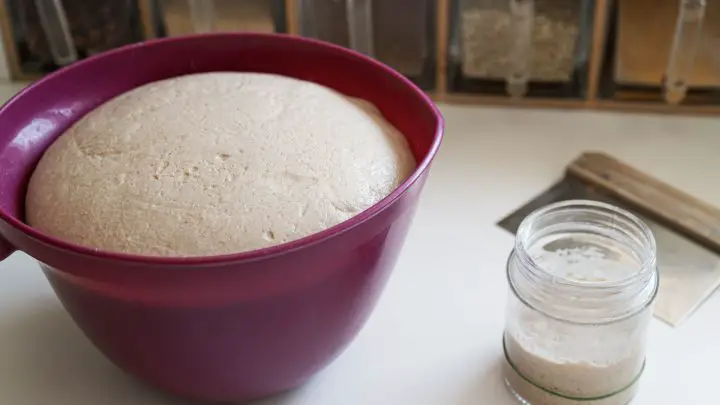
What to do With Sourdough Discard?
You can use the sourdough discard in a multitude of ways, in some of your favorite recipes.
The most common way is to add it directly into bread dough, but you can also use it in pancakes and waffles. It’s delicious!
Once your starter has fermented, you can discard the excess and store the remaining amount in a jar or airtight container at room temperature for up to two weeks. Additionally, you can freeze it for up to three months!
If frozen, thaw the discard overnight on the counter before using.
Here are some incredibly delicious sourdough discard recipes for you to try:
- Sourdough Discard Pancakes
- Sourdough Discard Biscuits
- Sourdough Breakfast Rolls
- Sourdough Banana Bread
- Sourdough Discard Scones
Sourdough Discard Pancake
Making pancakes or waffles is a great way to make use out of your discarded starter.
The best way to do this, would be through adding a portion of discarded starter flour, sugar, milk, and other ingredients.
Alternatively, you could opt for the discard from a freshly fed starter. Simply cook this mixture in a hot, greased skillet just like you would do with any regular pancake.
Enjoy this with your favorite sweet topping!
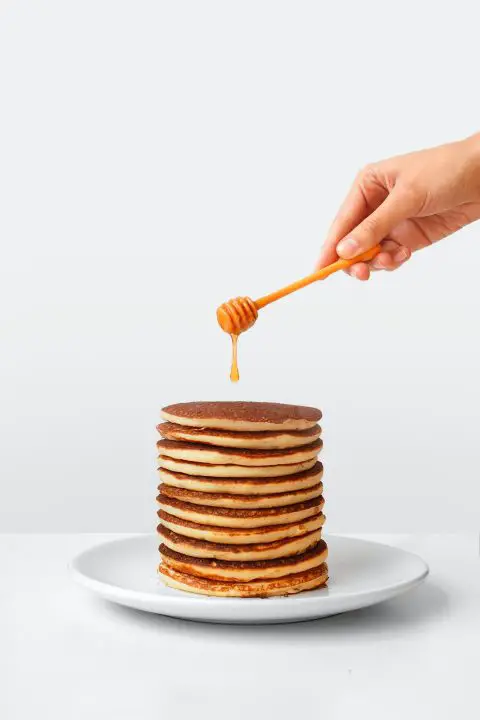
Sourdough Discard Biscuits
Another brilliant way of using your sourdough starter discard is by making biscuits.
In place of the classical buttermilk, the discard creates a very tender, slightly tangy dough for your biscuits. These are perfect to munch on with your favorite beverage, hot or cold.
You’ll definitely adore these biscuits!
Sourdough Breakfast Rolls
Using your sourdough starter discard you can whip up some deliciously tangy cinnamon rolls, cardamom buns, and other breakfast buns, that can be topped with a coffee cream cheese glaze.
Sourdough Banana Bread
Desperate not to waste that discard? Try making some banana bread.
Use some old bananas, and dried fruits, for that soft, crumbly texture, with a hint of twang.
Sourdough Discard Scones
Similar to making biscuits, replace the buttermilk with discarded sourdough starter.
This creates phenomenal flavors, and a soft crumb, with a texture that is neither biscuit nor muffin, but a taste that is heavenly.
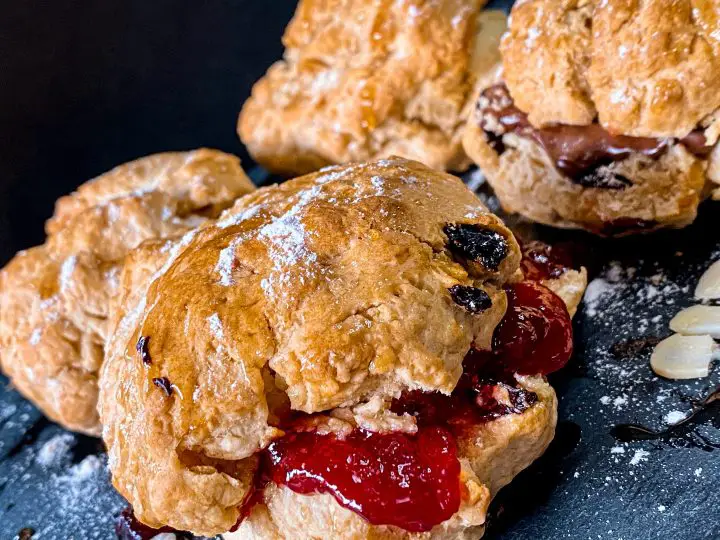
So What’s that Smell Coming From My Starter?
Your starter will release lots of smells during its fermenting process. As long as the smell isn’t identical to alcohol, acetone, or smelly socks, your starter should be good to go.
Your sourdough starter should emanate a sweet yeasty scent, that indicates that it is perfectly healthy.
Sourdough Starter Smell FAQs
How do you fix a sourdough starter that smells?
If your starter is constantly smelling sour, then try increasing, how often you feed it. If you normally feed it once a day, try feeding it twice a day.
How do you know if your sourdough starter is spoiled?
You can tell that your starter has spoiled or died once it no longer responds to regular feedings, especially if it has been unfed for a long time.
Why does my sourdough starter smell like feet?
Your sourdough starter will go through many stages of smells. It can be yeasty one day, and smell like alcohol the next. These are all perfectly normal, and can be fixed with extra feedings.

![Batard Sourdough Shaping [Your Ultimate Guide] 8 Batard sourdough shaping [the ultimate guide]](https://www.mydailysourdoughbread.com/wp-content/uploads/2022/12/CD-blog-images-2023-01-05T184157.343-120x120.jpg)


![How To Cold Proof Sourdough [Your Easy Guide] 11 How to cold proof sourdough [your easy guide]](https://www.mydailysourdoughbread.com/wp-content/uploads/2023/01/blog-images-40-120x120.jpg)
